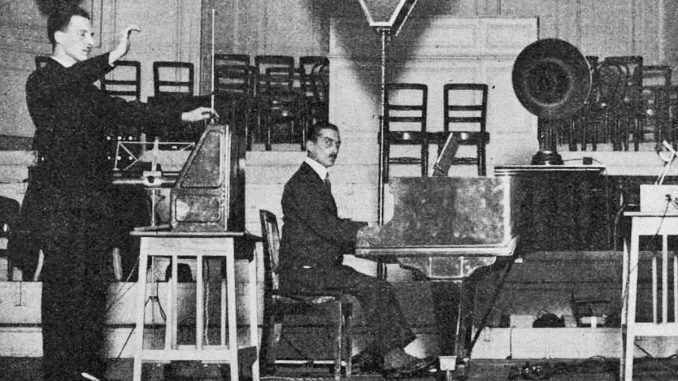
It was 1927, the height of the Roaring Twenties and America had well-and-truly shaken off the yoke of Victorian conservatism, embracing more liberal social and artistic norms. The relatively recent technologies of audio amplification and radio broadcasting had become well established, and musicians were eager to explore their potential not only in an effort to expand their audience but to also create new and interesting sounds.

Enter Leon Theremin. His arrival that year in New York City, the young man eager to demonstrate his new invention, an instrument which married aspects of radio and amplification, heralded the start of a new age of electronically-created music. Not only did his new instrument require no mechanical method of producing sound – no blowing, no striking, no sawing – the performer didn’t even touch it at all! She merely moved her hands in the air, varying their distances from two antennas, to adjust both volume and pitch.
Controlled by a talented performer, Theremin’s instrument could produce a rich variety of sound, from somber, low cello-like tones to agitated, high-pitched wailing. Sometimes, it could even bear an uncanny resemblance to a human voice! Theremin originally called his instrument the aetherphon and later the thereminvox but audiences insisted on associating the machine with the man, referring to it as simply the theremin, and the inventor was thereafter forever branded by his own invention – not that he minded that much, for his creation was about to give him far more than the standard fifteen minutes of fame.
By the time Theremin stepped on to the American shore in 1927 his theremin had already developed a bit of a reputation in the musical world. The first composition expressly for the instrument, “A Symphonic Mystery” by Russian composer Andrej Filippowitsch Paschtschenko had been premiered by the Moscow Philharmonic four years earlier, and audiences during a European tour earlier in 1927 had been wildly enthusiastic. Therefore, it was really no surprise that his New York demonstration concert was widely praised, subsequently creating a sensation amongst both musicians and listeners. Theremin set up a laboratory in the city to build new instruments and train performers to use them, and soon theremin concerts became commonplace.
It might seem curious to the modern reader that something that seems so mundane (and perhaps even chiché) today was able to create such a stir, but from the point of view of the 1920s, the field of electronics still seemed like science fiction, and new electronic devices couldn’t have appeared more strange to the average individual if they had been knowingly brought back from the far future using a time machine.
So while the theremin’s practical use was limited, people were in awe of it for what it was as much as what it did – just half a century earlier there was no electric lighting, no telegraph, no radio, no telephone, no automobiles…it seemed as if there was no limit as to where this new technology could take humanity, and the theremin exemplified that notion, inspiring the imagination to consider just what the possibilities were, and what fantastic innovations and strides the future could bring – even the crazy idea of a man walking on the Moon.
Theremin performers often seemed as if they had come from the future (and the Moon), their rigid postures and strange gestures summoning forth other-worldly sounds and (often unintentional) dissonances that, to a listener used to a very fixed tonal scale and the aural characteristics of common acoustic instruments, must have made them wonder when they would be able to board a flight to the Moon themselves – it was a magical time.
And the theremin was a magical invention. In 1929, attracted by its ballooning popularity, RCA purchased a license to manufacture the instrument and quickly produced around two hundred of them. RCA marketed their theremin toward the home consumer, advertising it as a simple instrument to learn (“nothing more complicated than waving one’s hands in the air!”) that could be mastered by anyone who could “hum or whistle”: “(I)t is the simplest and most universal of musical instruments, because no technical knowledge of music, no tedious practice, no long period of study is necessary in order to play it.”
Of course, the reality was the theremin was an extremely difficult instrument to master. Players needed a very good sense of relative pitch in order to land notes at their correct frequencies when accompanied, and perfect pitch in order to pull off a solo performance – a very rare talent. There were few customers who, after forking out US$600 (US$8800 in 2018!) for their shiny – but ultimately mostly useless – new wonder, were pleased with their purchase once they (or their family members) attempted to play it.
The 1929 stock market crash and the subsequent financial depression put the final nail in the coffin of the theremin as a commercial product, and it was never widely adopted. But its legacy lived (and still lives) on in science fiction and horror movie soundtracks.

Be the first to comment